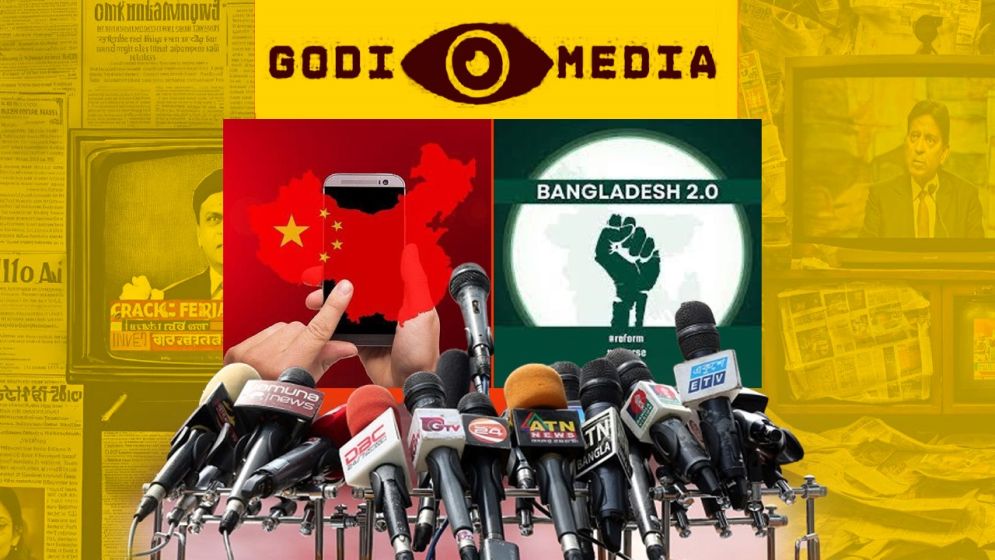Why China is backing Bangladesh in South Asia’s shifting battleground of media narratives

Following the 2024 uprising in Bangladesh, China has emerged as a strategic partner in countering Indian disinformation campaigns. As the regional information war intensifies, a new China-Bangladesh alignment challenges India’s long-standing media dominance in South Asia.
On June 5, Bangladesh’s Business Standard newspaper reported that China is actively assisting the Bangladeshi state in addressing what it terms "false information and negative propaganda" attributed to India and its digital affiliates.
A Chinese diplomat in Dhaka has been appointed to coordinate this effort, and joint media defense seminars with Bangladesh’s Ministry of Information are being planned.
This development signifies a geopolitical reorientation. Since the removal of Sheikh Hasina’s Awami League on August 5, India's broadcast media, often referred to as "godi media," has intensified its coverage of Bangladesh.
The aim appears to be to discredit the interim government, undermine the credibility of figures like Chief Adviser Muhammad Yunus, and portray the uprising as chaotic, necessitating a "restoration" of the previous leadership or a closely aligned alternative.
This information campaign has extended beyond Bangladesh's borders. Similar tactics, including manipulated imagery and orchestrated media narratives, were observed during India's recent confrontation with Pakistan, suggesting a consistent approach to leveraging media for state objectives.
This pattern of information dissemination is attracting international attention and documentation.
A 2023 investigation by EU DisinfoLab identified a network of over 750 fabricated news websites operating in 119 countries, linked to India’s Srivastava Group.
This group specializes in disseminating pro-India, anti-Pakistan, and anti-China narratives, often by reactivating defunct UN-accredited NGOs and creating fictitious journalists to enhance credibility.
Similarly, Stanford University’s Internet Observatory, in collaboration with Graphika, has documented instances where Indian disinformation entities utilized fake accounts, troll farms, and manipulated media to suppress dissent, including in contexts such as Kashmir, the farmers’ protests, and currently, Bangladesh.
These activities, those journals said, are characterized as strategic disinformation campaigns.

China’s Soft-Power Counteroffensive
Bangladesh, demonstrating increased assertiveness, appears prepared to counter these tactics, potentially with support from a global power like China that has experience in similar hybrid warfare strategies.
China's offer of assistance to Bangladesh in the information sphere is essentially a strategic move in the ongoing geopolitical competition.
Beijing views the interim government in Bangladesh, following the change in leadership, as an opportunity to support a strategically located nation moving away from India's traditional sphere of influence.
This support in the information domain is also aimed at recalibrating the balance of influence in South Asia.
China has historically faced scrutiny from Western media regarding issues such as Hong Kong, Xinjiang, and Taiwan. In response, China has developed a structured and centralized approach to counter-disinformation, employing data-driven messaging, algorithmic monitoring, and diplomatic counter-narratives supported by institutional frameworks.
These tools are now being extended to Bangladesh as part of a collaborative effort.
For an extended period, India held a dominant position in South Asia's media landscape, with its cultural output and news narratives often shaping regional perspectives.
Under the previous Awami League government, Bangladesh largely aligned with these narratives. However, the change in government through a massive uprising has altered this dynamic.
This is because the interim government has encountered a sustained campaign of narrative disruption. Indian television has characterized the transition as an "Islamist coup," and anonymous opinion pieces forecasting Bangladesh's instability have appeared on international platforms.
Furthermore, Bangladeshi dissenting voices online have reportedly experienced algorithmic suppression and targeted cyber-attacks.

What does China’s support entail?
Now, with China's technical and diplomatic support, Bangladesh is shifting from a reactive stance to proactively shaping information narratives, creating ripple effects across the region.
And at the same time, India's previous near-monopoly on information is showing signs of weakening, as evidenced by Nepal's media challenges with Indian information control and Sri Lanka's frustrations regarding narrative manipulation during its debt crisis.
So, under the current circumstances, the emergence of a more diverse information environment, potentially centered around a China-Bangladesh alignment, suggests a move towards regional plurality rather than a shift to Chinese dominance.
This development is not about replacing one dominant power with another; rather, it signals a challenge to India’s historically disproportionate and often misused influence over how information about South Asia is interpreted and shared.
Should other nations–such as Pakistan, Nepal, the Maldives, or Sri Lanka–choose to align, a counter-narrative coalition could emerge.
Such a coalition would not only contest India’s dominance in shaping regional discourse but also question the passive acceptance of these narratives by Western institutions.
In this context, China’s support for Bangladesh in the information sphere marks a notable shift in the dynamics of regional influence. India, long accustomed to shaping South Asia’s image through its media networks, is increasingly encountering resistance to its traditional methods.
Narratives that once went unchallenged are now facing organized pushback, and the dramatic framing typical of Indian media is being met with well-substantiated counterpoints.
As the information landscape evolves, India's assertive communication strategy may begin to work against it.
—
Omar Faris is a writer and an analyst

